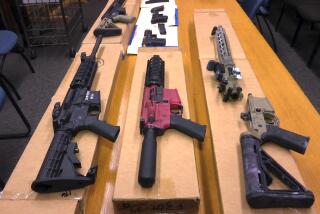Court Curbs Police Shootings : Rules They Can’t Fire at Unarmed, Fleeing Suspects
- Share via
WASHINGTON — The Supreme Court ruled today that police may not shoot unarmed suspects fleeing from crimes when there is no apparent threat of harm to police officers or others.
By a 6-3 vote, the court struck down a Tennessee law that authorized police to shoot at fleeing felons, a statute said to be similar to those in about half the states.
(The ruling is expected to have no impact on the Los Angeles Police Department, which already prevents its officers from shooting at fleeing felony suspects who are not deemed to be a threat, said Officer Margie Mastro, department spokeswoman.
(“It’s really no big deal,” she said. “What the Supreme Court said falls right in line with our policy.”)
Deadly Force Issue
The court said the Tennessee law was unconstitutional insofar as it authorized deadly force against apparently unarmed, non-dangerous fleeing suspects.
“It is not better that all felony suspects die than that they escape,” said Justice Byron R. White for the court.
“Where the suspect poses no immediate threat to the officer and no threat to others, the harm resulting from failing to apprehend him does not justify the use of deadly force to do so,” White said.
The ruling does not prevent police from using deadly force when there is “probable cause” to believe the suspect is dangerous.
White said the Tennessee law is constitutional only in authorizing police to shoot to kill “if the suspect threatens the officer with a weapon or there is probable cause to believe that he has committed a crime involving the infliction or threatened infliction of serious physical harm.”
Preventing Escape
In such cases, White continued, deadly force is permissible to prevent escape “if, where feasible, some warning has been given.”
In a dissenting opinion, Justice Sandra Day O’Connor said the ruling creates a constitutional right “allowing a burglary suspect to flee unimpeded from a police officer who has probable cause to arrest, who has ordered the suspect to halt and who has no means short of firing his weapon to prevent escape.”
She was joined by Chief Justice Warren E. Burger and Justice William H. Rehnquist.
Today’s ruling stemmed from the Oct. 3, 1974, shooting of a 15-year-old burglary suspect in Memphis.
Court records showed that police officer E. R. Hymon and his partner were checking into a reported burglary in progress when they saw Edward Eugene Garner running from the house.
Ordered to Halt
Hymon, who could see the boy was unarmed, shouted, “Halt.” As the boy jumped to the top of a fence, Hymon fired and killed the boy.
The officer later testified that he fired at Garner because he was sure that once the youth cleared the fence, he could easily escape.
In another significant case today, an evenly divided court upheld a ruling that forces a New York community to provide public land for a privately sponsored Christmas Nativity scene each year.
By a 4-4 vote, the justices ruled that Scarsdale, N. Y., must permit the placing of a Nativity scene in the park in the middle of town.
Such tie votes, however, do not set any national precedent because it is possible that in some future case the same issue will be decided by all nine justices.
More to Read
Sign up for Essential California
The most important California stories and recommendations in your inbox every morning.
You may occasionally receive promotional content from the Los Angeles Times.











